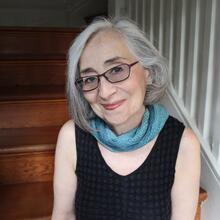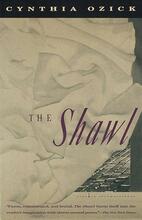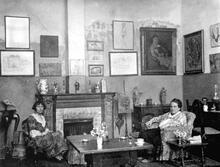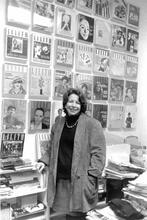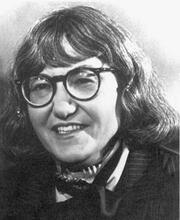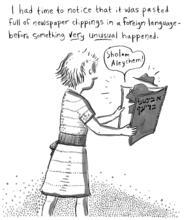Cynthia Ozick
"I wanted to use what I was, to be what I was born to be—not to have a 'career,' but to be that straightforward obvious unmistakable animal, a writer," Cynthia Ozick once said. She has certainly achieved her goal. The winner of numerous literary awards, Cynthia Ozick is a writer par excellence, author of essays, plays, short stories and novels.
Institution: The Jacob Rader Marcus Center of the American Jewish Archives, Cincinnati, OH, www.americanjewisharchives.org and Gerard Murrell.
Cynthia Ozick has won widespread acclaim for her novels and short stories depicting the Jewish-American experience and for her memorable, nuanced female characters. Ozick studied at a boy’s heder, gaining an early love of Yiddish and of Jewish culture that would infuse her work. She went on to Ohio State University, discovering a passion for Henry James, whose writing deeply influenced her own. Her first published novel, Trust, appeared in 1966, followed by five more novels, fourteen collections of short stories and essays, and two plays. She has received the highest honors in the literary world for her powerful and challenging prose: three O. Henry prizes, fellowships from Guggenheim and the National Endowment for the Arts, two PEN awards, and a National Book Critics Circle Award.
Introduction
In conversation, one hears a soft, youthful tinkle, clear as a bell. Then there is the unfailing Old World politeness, the refinement of language, and a bright eagerness in the voice to share her thoughts, to hold nothing back. Yet, if the voice is poetry, the words are prophecy. One will hear this in the deep insights, the well-wrought thought, the keen incisiveness, and the sharp wit. These will come later—but they will come.
There is simultaneously something very young and something decidedly hoary about the persona of Cynthia Ozick. She herself recognizes this duality. In “The Break,” a virtuoso comic performance that first appeared in the Spring 1994 issue of Antaeus, her younger self (who goes by the Hebrew name of Shoshana) solemnly announces her disengagement from the “white-haired, dewlapped, thick-waisted, thick-lensed hag” (who goes by the Greek name of Cynthia)—a writer disgustingly devoid of that hunger for success that drives great artists. What does this “seventeen-to-twenty-two-year-old” energetic, ambitious writer, who sees a whole row of luminescent novels on the horizon, have in common with this sixty-six-year-old woman who is resigned to her failures? “I would not trade places with her,” shouts Shoshana, “for all the china in Teaneck.”
Family and Early Life
Cynthia Ozick was born in New York City on April 17, 1928, the second of two children. She subsequently moved to the Bronx with her parents, Celia (Regelson) and William Ozick, who were the proprietors of the Park View Pharmacy in the Pelham Bay section. Her parents had come to America from the severe northwest region of Russia. More important for an insight into Ozick’s temperament, they came from the Litvak [Lithuanian] Jewish tradition of that region. That is a tradition of skepticism, rationalism, and antimysticism, opposed to the exuberant emotionalism of the Hasidic community that flourished in the Galitzianer [Galician] portion of Eastern Europe. This explains, perhaps, why the Hasidic rebbe in Ozick’s story “Bloodshed” is such a reasonable man, almost a Litvak. Ozick herself, she does not tire of repeating, is a misnaged, an opponent of mystic religion. In her stories, however, she wallows in mysticism.
Ozick describes the life of her parents with reverence. It was not unusual for them to put in a fourteen-hour day at the drugstore, often closing the store at one in the morning. Cynthia herself served as the delivery girl of prescriptions. Ozick describes her mother’s life as a life of total generosity, of lavishness, of exuberance, of untrammeled laughter. Her father, a discreet, quiet man, a talmid hokhem [a Jewish scholar], who also knew both Latin and German from his Russian gymnasium years, ground and mixed powders and entered prescriptions meticulously in his record book. It is not without interest that, according to his daughter, he wrote beautiful Hebrew paragraphs and had a Lit. "teaching," "study," or "learning." A compilation of the commentary and discussions of the amora'im on the Mishnah. When not specified, "Talmud" refers to the Babylonian Talmud.Talmudist’s rationalism.
However, life was not without its childhood pain. At the age of five and a half, Ozick entered heder, the Yiddish-Hebrew “room” where, in the America of those years, Jewish pupils were sent for religious instruction. There she was confronted by a rabbi who told Cynthia’s bobe [grandmother], who had accompanied her granddaughter to school, in Yiddish, “Take her home; a girl doesn’t have to study.” Ozick dates her feminism to that time and is especially grateful to her grandmother for bringing her back to school the very next day and insisting that she be accepted. Even the rabbi, to whom Ozick appears to bear no lasting animosity, had occasion to be grateful, for this girl had, as the rabbi would quickly learn, a goldene kepele [golden little head] that caught on quickly to the lessons. Ozick owes her knowledge of Yiddish to a certain Rabbi Meskin, a teacher who “taught girls as zealously as he taught boys,” and to her grandmother.
At P.S. 71 in the Bronx, the hurt was of a different order. At home and in heder, the young girl was considered intelligent. In school, on the contrary, she was made to feel inadequate. She was, however, excellent in the bookish arts, such as grammar, spelling, reading, and writing. While Ozick describes the Pelham Bay section of the Bronx as a lovely place, she found it “brutally difficult to be a Jew” there. She remembers having stones thrown at her and being called a Christ-killer as she ran past the two churches in her neighborhood. She was particularly uncomfortable in school because she would not, on principle, sing the particularly Christian Christmas carols, and was made “a humiliated public example for that.” While writing The Cannibal Galaxy, a novel set in a Jewish all-day school, she asserts, “I thought of my own suffering, deeply suffering wormlike childhood in grade school; and of my mother’s endurances in grade school as an immigrant child.... Carelessness in a teacher of small children can burn in impotence for life, like a brand or horrible sign.”
All was not dreariness in her childhood, however, for there remained the world of books. In “A Drugstore in Winter,” Ozick describes how reading and “certain drugstore winter dusks” came together thanks to the traveling library that arrived in her neighborhood every other week. She recalls that the librarians would come into the Park View Pharmacy after their rounds to have a cup of hot coffee at the fountain. Ozick would come in behind them, having chosen the two fattest volumes from the boxes of books and magazines offered to her. With these books in her hands, she was transported to another world.
She began her reading with fairy tales. From her older brother, she received the perfect birthday present—books. These books had a magical effect, transforming her from a doltish schoolgirl into “who I am”—a reader, and perhaps a writer. “Some day when I am free of P.S. 71, I will write stories. Meanwhile, in winter dusk, in the Park View, in the secret bliss of the Violet Fairy Book, I both see and do not see how these grains of life will stay forever.”
Ozick owes her metamorphosis into a writer to the fact that her mother’s brother, Abraham Regelson, was a Hebrew poet of no mean reputation. She feels that, somehow, he paved the way for her to embark on such a “strange” career—writer. Because of him, she says, “it seemed quite natural to belong to the secular world of literature.” At one time, she attributed her freedom to choose such a “frivolous” career as writer to her gender. “My father loved me,” she told an interviewer, “but I think one of the reasons from earliest childhood I felt free to be a writer is that if I had been a boy, I would have had to go be something else.”
Higher Education
School became a serious pursuit for Ozick when she entered Hunter College High School in Manhattan. There she was made to feel part of an elite, a Hunter girl, in a place where academic excellence set one apart. Ozick describes this feeling fleetingly in the short story “An Education,” in which Una Meyer excels in Latin, and in the long novel, Trust, contrasting the heroine’s fruitful academic experience with her mother’s empty-headed schooling at Miss Jewett’s finishing school.
In a reminiscence she entitled “Washington Square, 1946,” she tells how, eager for the new life awaiting her in college, she arrived a day early at the as yet unpopulated and therefore desolate campus of Washington Square College of New York University in Greenwich Village. In the Village, she discovers a newsstand that carries the Partisan Review, the journal of the literary avant-garde. Ozick will purchase her first non-textbook-book and browse through the Village’s secondhand bookstores with the literary longing of youth. She will become a writer.
But first she would have to become an “old man.” On graduation from college, Ozick set out for Columbus, Ohio, where, at Ohio State University, she pursued a graduate degree in English literature, earning a master’s degree with the thesis “Parable in the Later Novels of Henry James.” As she confesses in “The Lesson of the Master,” she “became Henry James.” She explains how she was influenced by him to become a worshiper of literature, one who, having to choose between ordinary human entanglement—real life—and exclusive devotion to art, chooses art. She chose art over life, she says, to her eternal regret. Ozick asserts that she acted on the teaching of her mentor at the wrong time, while still a youth. It is not clear, however, that she did in fact abandon la vraie vie, as Proust puts it, for, at the age of twenty-four, in 1952, she married Bernard Hallote. Upon receiving his degree, he would become a lawyer for the city of New York.
Early Works and Jewish Writings
It is true, nevertheless, that during the first thirteen years of her marriage Ozick devoted herself exclusively to what she called “High Art,” working on a philosophical novel, Mercy, Pity, Peace, and Love, called “MPPL” for short. Ozick would abandon this effort after several years, “a long suck on that Mippel,” she would remark wryly. She also spent six and a half years, from 1957 to 1963, on Trust, another massive novel, published in 1966. In a reflection of the times, Trust was reviewed positively in Time magazine—whose reviewer referred to Ozick as a “housewife.” Another renowned critic referred to her as “a lady writer,” a designation she abhorred.
Ozick underwent a cultural transformation during that period. She became a Jewish autodidact, mastering for herself much of the Jewish textual tradition. Having read, at age twenty-five, Leo Baeck’s “Romantic Religion,” an essay that “seemed to decode the universe for me,” she was further influenced, by Heinrich Graetz’s History of the Jews, to add a Jewish nuance to Trust.
By becoming a “Jewish writer,” Ozick did not abandon the world. But she did begin to wrestle with the term “Jewish writer.” In 1965, the same year her daughter Rachel—today a PhD in biblical archaeology—was born, she published several poems on Jewish themes in Judaism and produced “The Pagan Rabbi,” published in 1966. She also wrote a hilarious short story based loosely on the career of Isaac Bashevis Singer, “Envy; or Yiddish in America,” published in Commentary in 1969.
Literary Criticism and Acclaim
Ozick’s stature grew quickly. Three of her stories have won first prize in the O. Henry competition, and five of her stories were chosen for republication in the yearly anthologies of Best American Short Stories. The editor of the 1984 volume called her one of the three greatest American writers of stories living today. She was nominated for the National Book Award and the PEN/Faulkner Award and won half a dozen coveted awards and grants, including both a Guggenheim and a National Endowment for the Arts Fellowship. She was also given the precious commodity of time in the form of the American Academy of Arts and Letters Mildred and Harold Strauss Living Award for five years to pursue her craft. She has received several honorary doctorates and was invited to deliver the Phi Beta Kappa Oration at Harvard University. In 1986, she was the first recipient of the Michael Rea Award for career contributions to the short story. In 2000 she received the Lannan Foundation’s Literary Award for Fiction.
After Trust, Ozick shied away from the novel, publishing at regular intervals The Pagan Rabbi and Other Stories (1971), Bloodshed and Three Novellas (1976), and Levitation: Five Fictions (1982). She returned to the novel quirkily, as the result of the settlement of a threatened lawsuit by a Jewish day school headmaster who had read himself, justifiably or not, into the 1980 short story, “The Laughter of Akiva.” That story, enlarged and completely rewritten, became the novel The Cannibal Galaxy (1983). Another novel, The Messiah of Stockholm (1987), is sandwiched between two volumes of essays, Art and Ardor (1983) and Metaphor and Memory (1989). A third volume of essays, Fame and Folly, containing pieces on T.S. Eliot, Anthony Trollope, and Isaac Babel, was published in 1996. Meanwhile, in England, an essay collection called Portrait of the Artist as a Bad Character was published.
Literary Themes and Characters
Of Ozick’s fascinating female characters—from Sheindel, the sheytl-wearing (Yiddish) Rabbi's wife; title for a learned or respected woman.rebbetzin [bewigged rabbi’s wife] in “The Pagan Rabbi,” to Hester Lilt, the “imagistic linguistic logician” of The Cannibal Galaxy, to Rosa, the bag-lady Holocaust survivor of “The Shawl”—none is more beloved by admiring readers than Ruth Puttermesser, the protean heroine of Ozick’s 1997 novel, The Puttermesser Papers. At first glance, one would characterize Puttermesser neither as heroine nor as beloved. She certainly would not be taken as a role model in either of the worlds to which she clings: the legal profession and the Jewish community, writ large. Most likely modeled on Ozick’s lawyer-husband as much as on the writer herself, Ozick’s Puttermesser is beloved for her intelligent and exemplary readings of the Jewish textual tradition, for her practical involvement in the repair of the world, and for her ability to mingle the law with the lore. She is beloved because, although she is finally defeated, like all of us, by entropy, she teaches, by example, that every innocuous butter knife (the meaning of Puttermesser) can cut through life to its core of meaning. As Ozick stated in a piece published in a special edition of Life magazine on “The Meaning of Life,” “Our task is to clothe nature, ... to impose meaning on being.... Our task is the discipline of standing against nature when nature-within-us counsels terrorizing.... Our task is to invent civilization.”
That is Puttermesser speaking, but it is also Rosa. In 1980, Ozick published, in the New Yorker, “The Shawl,” two thousand words of finely honed impressionism, a rendering in miniature of the Holocaust in all its horror. A movingly dramatic reading of “The Shawl” by actress Claire Bloom was featured in 1995 on Jewish Short Stories from Eastern Europe and Beyond, a National Public Radio series subsequently published on audiocassette by the National Yiddish Book Center. In 1983, again in the New Yorker, Ozick published a sequel to “The Shawl,” expanding it into “Rosa,” a novella whose heft permitted her publisher to issue The Shawl (1989) as a separate volume, consisting of the story and the novella. Probably the most widely accessible of Ozick’s demanding prose works, it is now found on the reading lists of most college courses on the literature of the Holocaust, along with works by Elie Wiesel and Primo Levi. Ozick told the Paris Review in an interview that she would prefer not to make art out of the Holocaust. “I don’t want to tamper or invent or imagine, and yet I have done it. I can’t not do it. It comes. It invades.” She moved from the modern paradigm of suffering to its ancient counterpart in her preface to the The Book of Job (1998), in which she examines the linguistic, narrative and philosophical elements of the Biblical work.
If the Holocaust has invaded Ozick’s consciousness—it is present in different guises in “The Pagan Rabbi,” “Levitation,” and The Messiah of Stockholm as well—all the more so has the ugly phenomenon of Holocaust denial invaded her conscience. In an article in the Washington Post Book World (January 15, 1995), explaining how she came to write the play Blue Light (1994), she relates how, as early as 1961, she came to realize that the world had attenuated the Holocaust into the “Second World War,” as though Zyklon B, the deadly gas used to murder Jews, were nothing more than an artifact of war. The road from attenuation to revisionism to Holocaust denial became an increasingly simple one for her to trace.
Playwrighting and Theatrical Involvement
During her fifth decade as a writer, Ozick became what she has called an “elderly novice.” She had long before promised herself that she would one day write for the theater. Eager to wallow in the “delectable theatrical dark,” she decided in 1990 to dramatize for the stage “The Shawl” and “Rosa.” The play was originally scheduled to be produced by Robert Brustein at the American Repertory Theatre in Cambridge, Massachusetts. Ozick did several rewrites—making the figure of the denier more and more “satanic”—but the production was canceled for budgetary reasons. In 1992, after more revisions, the play received two staged readings in New York at Playwrights Horizons. Its first full-blown production, under the direction of Sidney Lumet, took place at Sag Harbor’s Bay Street Theatre. Finally, after fifteen or so revisions, The Shawl was produced off-Broadway, at Playhouse 91 of the American Jewish Repertory Theatre, in 1996.
Given Ozick’s stature in the literary world, the play received considerable critical attention. Ben Brantley, reviewing it in the New York Times (June 21, 1996), was awed by Ozick’s power “to let us temporarily, but thoroughly, inhabit someone else’s mind.” What Brantley missed, however, was Ozick’s intention “not to be merciful to the cruel,” that is, to the Holocaust deniers.
Although Ozick has only good things to say about Sidney Lumet and the other theater people she worked with, she expressed regret that she had to spend so much time on the mechanics and staging of this play, time that otherwise might have been spent “breathing inside a blaze of words,” practicing the solitary art of the prose writer. Her return to the essay and to prose fiction marked yet another beginning for Ozick, and the product was as fresh as the work of a young experimental novelist. Witness her entry into cyberspace in the fall of 1996 with a ten-day “Diary” on Michael Kinsley’s Internet magazine Slate. (In the “Diary,” Ozick reveals that she has been keeping a private diary since 1953, when she was twenty-five years old.)
She returned to questions of the Holocaust—including “Who Owns Anne Frank?”—and other issues in her 2001 book of essays Quarrel and Quandary, which won the National Book Critics Circle Award for criticism. Ozick suggests that the Holocaust is almost—but not quite—resistant to the literary efforts to encompass it. She was particularly angered by the morphing of Frank’s diary into Broadway-style cheerfulness, a transformation that “tampers with history, with reality, with deadly truth.”
Later Writings
In 2001 Ozick received the Guardian of Zion Award from Bar-Ilan University “in recognition of her contribution to literature; and in particular, in recognition of her spirited defense of the Jewish People and Zionism in her non-fiction writing and public speaking.”
Ozick returned to fiction in 2004 with the publication of Heir to the Glimmering World, the first-person narrative of a teenage orphan girl who is employed by a German-Jewish scholar studying an ancient Jewish heretical sect. Ozick also had pieces on The Portrait of a Lady and Gertrude Stein, as well as a fictional account of a visit from a Muscovite cousin, published in her regular outlets, the New York Times Book Review, the New York Times Magazine, and the New Yorker. Telling much about the heights that she reaches in American literature, in 1997 the New Yorker published a major essay by Ozick on Dostoyevsky. Posterity will judge whether Fyodor and Shoshana-Cynthia are playing in the same Garden.
Selected Works by Cynthia Ozick
Antiquities (2021).
Letters of Intent (2017).
Critics, Monsters, Fanatics, and Other Literary Essays (2016).
Foreign Bodies (2010).
Heir to the Glimmering World: A Novel (2004).
Quarrel and Quandary: Essays (2001).
The Book of Job, preface by Cynthia Ozick (1998).
The Puttermesser Papers (1997).
A Cynthia Ozick Reader (1996).
Fame and Folly (1996).
The Shawl (play) (1996).
Blue Light (1994).
Metaphor and Memory (1989).
The Shawl: A Story and Novella (1989).
The Messiah of Stockholm (1987).
Art and Ardor (1983).
The Cannibal Galaxy (1983).
Levitation: Five Fictions (1982).
Bloodshed and Three Novellas (1976).
The Pagan Rabbi and Other Stories (1971).
Trust (1966).
Currier, Susan, and Daniel J. Cahill. “A Bibliography of the Writings of Cynthia Ozick.” Texas Studies in Literature and Language 25, no. 2 (Summer 1983): 313–321.
Lowin, Joseph. Cynthia Ozick (1988).
Mehegan, David. “Turning a Page.” The Boston Globe, November 15, 2004.
Moyers, Bill. “Heritage Conversation with Cynthia Ozick.” Transcript, WNET-TV, New York, April 3, 1986.
Teicholz, Tom. “[Paris Review Interview with] Cynthia Ozick.” Paris Review 102 (Spring 1987): 154–190.
Kauver, Elaine M. Cynthia Ozick’s Fiction: Tradition and Invention (1993).
Cohen, Sarah Blacher. Cynthia Ozick’s Comic Art: From Levity to Liturgy (1994).
Marcus, James. “Quarrel and Quandery: Essays.” Twentieth Century History Books.com, 2001.


